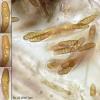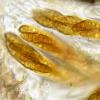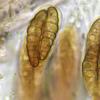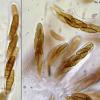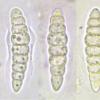
18-12-2025 21:17
Pol DebaenstThe identification took me to Byssonectria deformi

15-12-2025 07:09
 Danny Newman
Danny Newman
indet. Rutstroemiaceae sp. on unk. fallen leavesMc

19-12-2025 10:10
Patrice TANCHAUDBonjour, récolte réalisée en milieu dunaire, a

18-12-2025 17:23
 Bruno Coué
Bruno Coué
Bonjour,je serais heureux d'avoir votre avis sur c

18-12-2025 18:07
Margot en Geert VullingsThese plumes were found on rotten wood.They strong

17-12-2025 18:35
 Michel Hairaud
Michel Hairaud
Bonjour à tous/Hi to everyone I am passing along

15-12-2025 15:48
 Danny Newman
Danny Newman
Melanospora cf. lagenaria on old, rotting, fallen

15-12-2025 15:54
 Johan Boonefaes
Johan Boonefaes
Unknown anamorph found on the ground in coastal sa

15-12-2025 21:11
 Hardware Tony
Hardware Tony
Small clavate hairs, negative croziers and IKI bb
 Hi,
Hi,I am trying to identify this small Phaeosphaeria growing on dead Juncus stems. It could be something around P. volkartiana - P. minuscula, but my literature (Leuchtmann 1984, Shoemaker&Babcock 1989) does not give me a species with the spore size 22-25x6-7µm.
The perithecia are very small (around 100-130µm), black, with indistinct ostiolus and partly embedded into epidermis. Asci are 80-105x11-14µm.
Mature spores almost have 6-7 septa with 5. cell thicker than the others. Lower part tapered, the whole spore surface is regularly echinulate as seen on the photos.
Une idée? merci pour votre l'aide.
amicalement,
björn

:/
edit: Ok I would call my finding as Massariosphaeria typhicola. If someone has another idea, please tell me ;)
regards,
björn
Hi Björn,
Yes, You're probably right. It's very closed to M. typhicola. Perhaps if you check again ascomatas, you will find longer ascospores ? Perhaps not and it would be interesting.
For waiting, keep this M. sp. cf typhicola in herbarium.
Alain

thank you for the opinion. Yes it would be interesting if there are no other bigger spores. This record was random, I just chipped up something from the surface and had only one fruitbody between substrate material. I did not expect it in this preparation. I hope I can find another fruitbody, if yes, I will check again and tell you something more about the spore size.
regards,
björn

I have made numerous preparates and only one of them had 2 additional fruitbodies with a bigger spore size (23-28x6-7µm). I think it is not mature at all because most spores were inside the asci.
In one of the preparates there were some other spores without asci. I took a photo of them too.
amicalement,
björn
and notice, all preparates were made from the same Juncus stem.
It really looks like M. typhicola.
Alain

Mysterious. But very interesting. I will collect some more Juncus stems next time, even if there is nothing to see :P
Thanks Alain.
Yes, I think. Ther is probablity variability in ascospores' length.
Alain

Perhaps the answers to your questions are in Leuchtmann (über Phaeosphaeria ...)
Alain

If there is something more of this M. roumegueri, I will post it here ;)
regards,
björn
This fungi seems to be very intersting i am working on pleosporales missing types and their phylogeny if you can send me a specimens then i can work on it and do sequecing
I look forward to hearing from you
Thanks
Hiran


